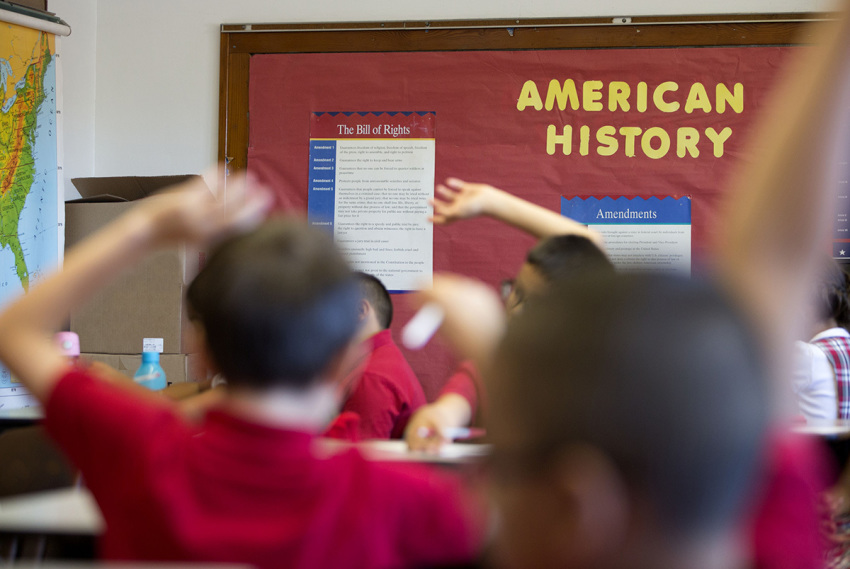Experts debate report claiming $700 billion needed to fix learning loss from pandemic closures

The cost of remedying setbacks to student learning caused by the COVID-19 pandemic lockdowns that led to school closures across the U.S. could be around $700 billion, a figure that some experts say is difficult to assess until more data is available.
A report published last month in Educational Researcher, a journal tied to the American Educational Research Association, an organization that advocates for scholarly inquiry to determine the best educational practices, suggests that the cost of restoring pre-pandemic learning levels requires more than what the federal government has already spent.
The study was co-authored by Kenneth A. Shores at the University of Delaware and Matthew P. Steinberg at George Mason University. The authors examined existing research from multiple sources, including the cost of increasing student achievement through the U.S. Department of Education and the U.S. Census Bureau. They also examined the time students spent learning remotely and analyzed prior estimates of learning loss.
Despite the federal government providing $190 billion to public K-12 schools through Elementary and Secondary School Emergency Relief (ESSER) funds in three bills in 2020 and 2021, the authors estimate that around $700 billion is needed to recover educational setbacks.
"Despite an extraordinary level of support by the federal government during the pandemic, U.S. schools are still $500 billion short of what's needed to address unpreceded levels of learning loss," Steinberg said in a statement.
"While the investment in ESSER was incredible in scale, it pales in comparison to the negative impact on the economy if a generation of children does not recover from what this pandemic has done to them academically."
Nat Malkus, senior fellow and deputy director of education policy at the American Enterprise Institute, contends that the study attempts to estimate something that is not easy to assess.
"How much will it cost depends on how far students are behind, which we don't really know to a great degree of accuracy, and the kind of services that it will take to catch them up and how much those cost," Malkus told The Christian Post.
Malkus stated that the data regarding how far behind students are is still coming out. He also stressed the importance of distinguishing between studies conducted close to when students returned to in-person learning and ones done after, noting the results are likely to differ.
"That doesn't mean kids aren't behind. They are. There's a lot of work to be done," Malkus said. "It's just getting clearer measures of exactly how much that is and what it's going to cost to catch those students up. It's an impossible task to do with any kind of specificity."
Lindsey Burke, the director of the Center for Education Policy at the conservative think tank Heritage Foundation, believes that providing families with options instead of allocating more money to public schools will help struggling students.
"Recent declines in math and reading achievement, low confidence in public schools, and the highest levels of support for school choice ever recorded show it's time for a change," she wrote in a statement to CP.
"Rather than continuing to throw more money at a near-monopoly education system, states should follow the lead of Arizona, and allow every student to exercise choice with an education savings account."
"Tens of thousands of families have already applied for an ESA in Arizona just in the few weeks since the program has been open to universal admission," Burke continued.
Earlier this year, the National Assessment of Educational Progress, also known as The Nation's Report Card, released a report that purportedly found historic declines in reading and math scores for 9-year-olds during the pandemic.
The NAEP tested about 7,400 9-year-old students from 410 schools in 2022, and 92% of the schools assessed this year were also tested in 2020.
"Average scores for age 9 students in 2022 declined 5 points in reading and 7 points in mathematics compared to 2020," the report stated. "This is the largest average score decline in reading since 1990, and the first ever score decline in mathematics."
Another study released in July by the National Center for Education Statistics, an arm of the U.S. Department of Education Institute, found that most public schools say COVID-19 is responsible for reported increases in student misbehavior. The study's data was collected from 846 participating schools between May 10 and May 24.
Eighty-seven percent of the public schools reported COVID-19 negatively impacted students' socio-emotional development for the 2021-2022 school year. Eighty-three percent agree students' behavior has taken a turn for the worse.
In their research, Shores and Steinberg find that ESSER funds were not likely distributed to places with the greatest learning loss since emergency aid was allocated to states through the Education Department's Title I program under pre-existing rules favoring states that spend more on education. They say this resulted in school districts nationwide that face similar levels of poverty receiving different funding.
Additionally, the authors are concerned that many school districts don't plan to use ESSER funding to offset learning loss and that policymakers have little recourse to know how ESSER funds are used.
"Policymakers should require, or least provide incentives to, school districts to use federal aid for remediating student learning losses," Steinberg said. "This is much more important than using it, for example, for new facilities construction — such as athletic fields — that have little to do with addressing the academic needs of students."



























